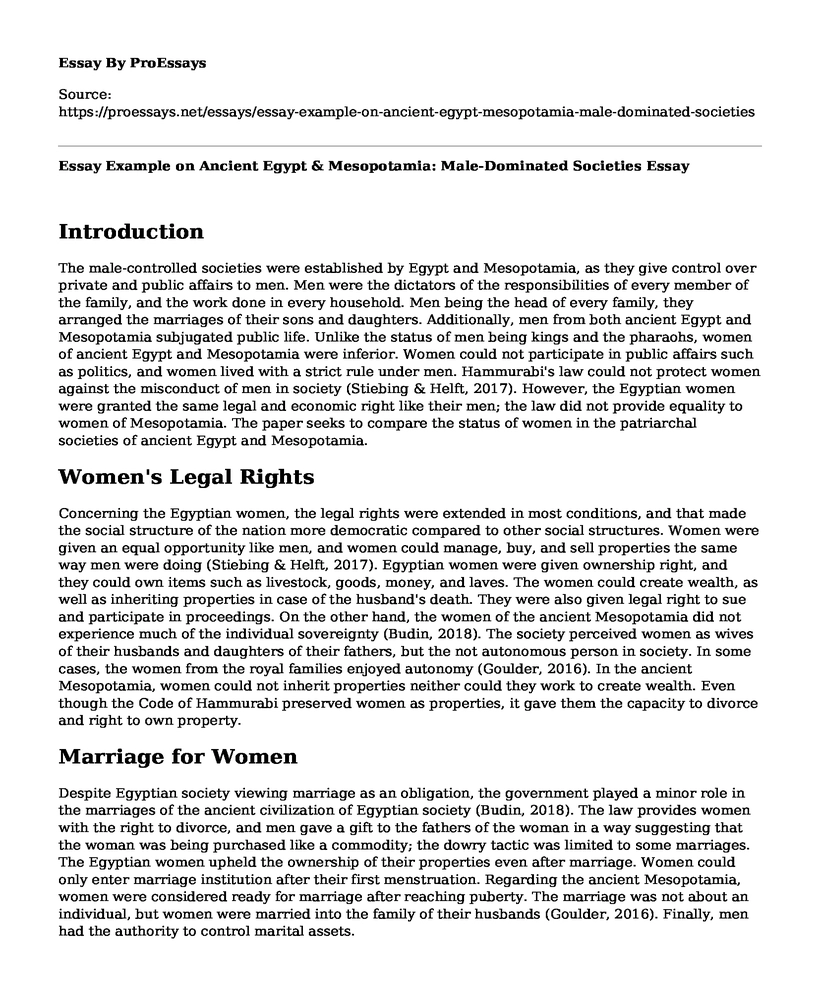Introduction
The male-controlled societies were established by Egypt and Mesopotamia, as they give control over private and public affairs to men. Men were the dictators of the responsibilities of every member of the family, and the work done in every household. Men being the head of every family, they arranged the marriages of their sons and daughters. Additionally, men from both ancient Egypt and Mesopotamia subjugated public life. Unlike the status of men being kings and the pharaohs, women of ancient Egypt and Mesopotamia were inferior. Women could not participate in public affairs such as politics, and women lived with a strict rule under men. Hammurabi's law could not protect women against the misconduct of men in society (Stiebing & Helft, 2017). However, the Egyptian women were granted the same legal and economic right like their men; the law did not provide equality to women of Mesopotamia. The paper seeks to compare the status of women in the patriarchal societies of ancient Egypt and Mesopotamia.
Women's Legal Rights
Concerning the Egyptian women, the legal rights were extended in most conditions, and that made the social structure of the nation more democratic compared to other social structures. Women were given an equal opportunity like men, and women could manage, buy, and sell properties the same way men were doing (Stiebing & Helft, 2017). Egyptian women were given ownership right, and they could own items such as livestock, goods, money, and laves. The women could create wealth, as well as inheriting properties in case of the husband's death. They were also given legal right to sue and participate in proceedings. On the other hand, the women of the ancient Mesopotamia did not experience much of the individual sovereignty (Budin, 2018). The society perceived women as wives of their husbands and daughters of their fathers, but the not autonomous person in society. In some cases, the women from the royal families enjoyed autonomy (Goulder, 2016). In the ancient Mesopotamia, women could not inherit properties neither could they work to create wealth. Even though the Code of Hammurabi preserved women as properties, it gave them the capacity to divorce and right to own property.
Marriage for Women
Despite Egyptian society viewing marriage as an obligation, the government played a minor role in the marriages of the ancient civilization of Egyptian society (Budin, 2018). The law provides women with the right to divorce, and men gave a gift to the fathers of the woman in a way suggesting that the woman was being purchased like a commodity; the dowry tactic was limited to some marriages. The Egyptian women upheld the ownership of their properties even after marriage. Women could only enter marriage institution after their first menstruation. Regarding the ancient Mesopotamia, women were considered ready for marriage after reaching puberty. The marriage was not about an individual, but women were married into the family of their husbands (Goulder, 2016). Finally, men had the authority to control marital assets.
Conclusion
The status of women varied significantly between the ancient societies of Mesopotamia and Egypt. The ancient women of Egypt enjoyed additional privileges and rights compared to the ancient women of Mesopotamia. For instance, the Egyptian women enjoyed the economic right of working and creating wealth, and inheriting properties after the death of their husbands, as well as the legal right of divorce; while the ancient Mesopotamia viewed women like the daughters of their fathers and wives of their husbands, and only the women from the first-class families enjoyed autonomy in some cases. In contemporary society, women enjoy the equal opportunity as men.
References
Budin, S. L. (2018). Fertility and gender in the Ancient Near East. In Sex in Antiquity (pp. 50-69). Routledge.
Goulder, J. (2016). Fair exchange: utilisation of working animals (and women) in ancient Mesopotamia and modern Africa. Anthropology of the Middle East, 11(1), 66-84.
Stiebing Jr, W. H., & Helft, S. N. (2017). Ancient near eastern history and culture. Routledge.
Cite this page
Essay Example on Ancient Egypt & Mesopotamia: Male-Dominated Societies. (2023, Feb 23). Retrieved from https://proessays.net/essays/essay-example-on-ancient-egypt-mesopotamia-male-dominated-societies
If you are the original author of this essay and no longer wish to have it published on the ProEssays website, please click below to request its removal:
- Historical Essay Example: The Rise and Fall of The Roman Empire
- Research Paper on Feminism and Marxism in the Brave New World
- Essay Sample on Women Education: Traditional to Modern
- Heroin Exposure in Pregnancy: Epidemiology, Triangle, and Community Health - Essay Sample
- Correctional Case Managers: Transforming Inmates for a Smooth Transition to Society - Esssay Sample
- Essay Example on Terrorism: The Rising Threat & Need for Collaboration
- Dominican Single Mothers in New York: Struggling to Make Ends Meet - Essay Sample







